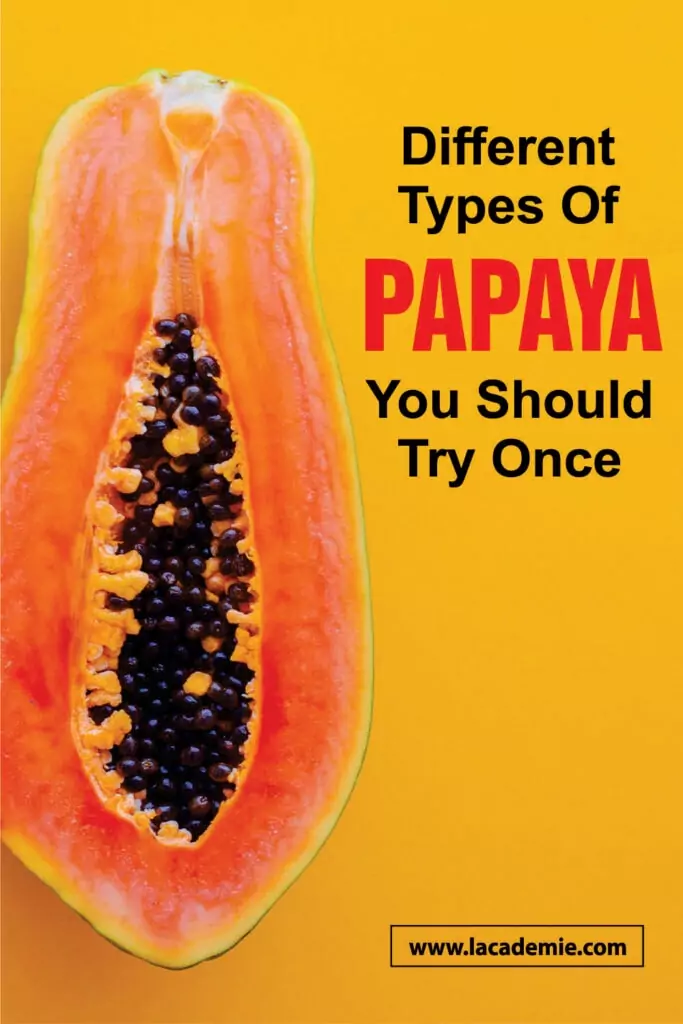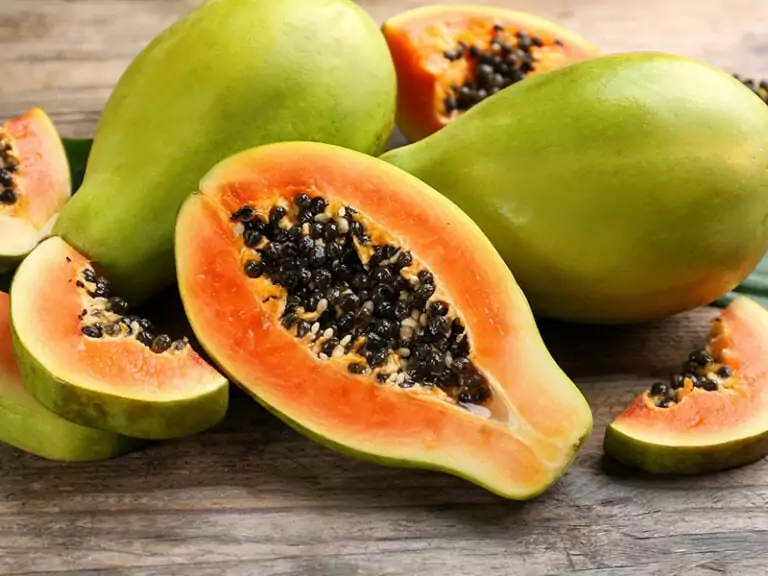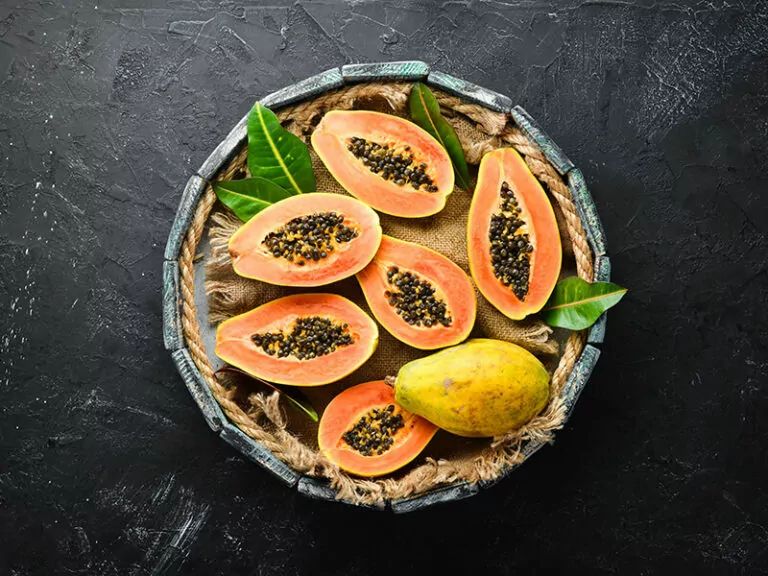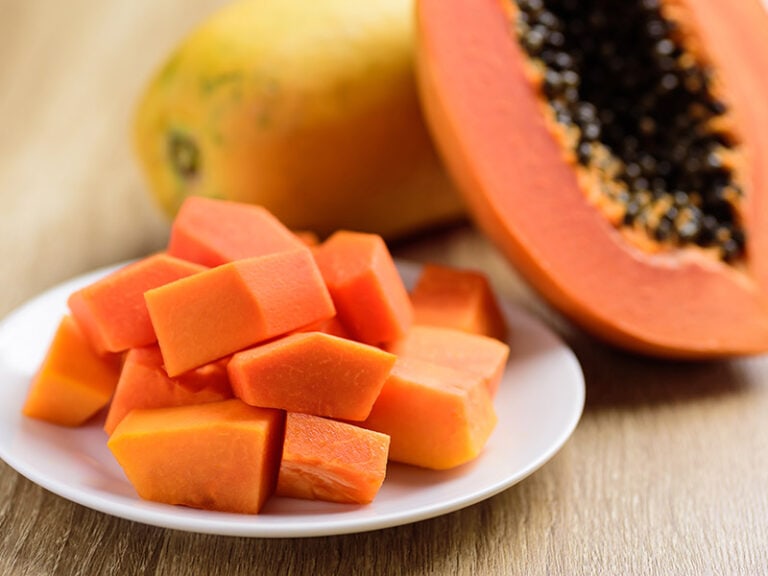Are you curious about different types of papaya? Do they have any common things in shape, flavor, or characteristics? This post will be a good source of information to help you dig deep into the world of this fantastic tropical fruit.
Keep reading and you can discover more about their names, origin, and what they look like. Now, I won’t let you wait anymore. Let’s jump into this comprehensive list.
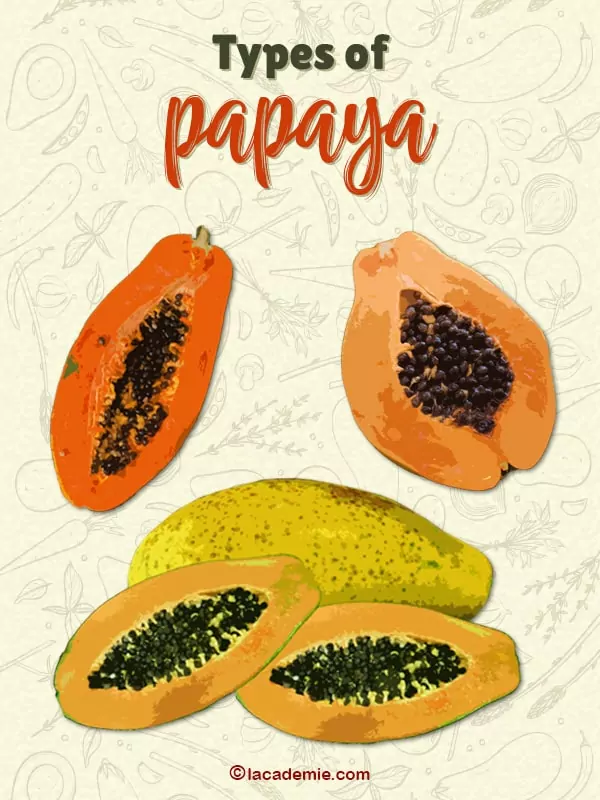
A Brief Overview Of Papayas – Treasure Of The Tropics
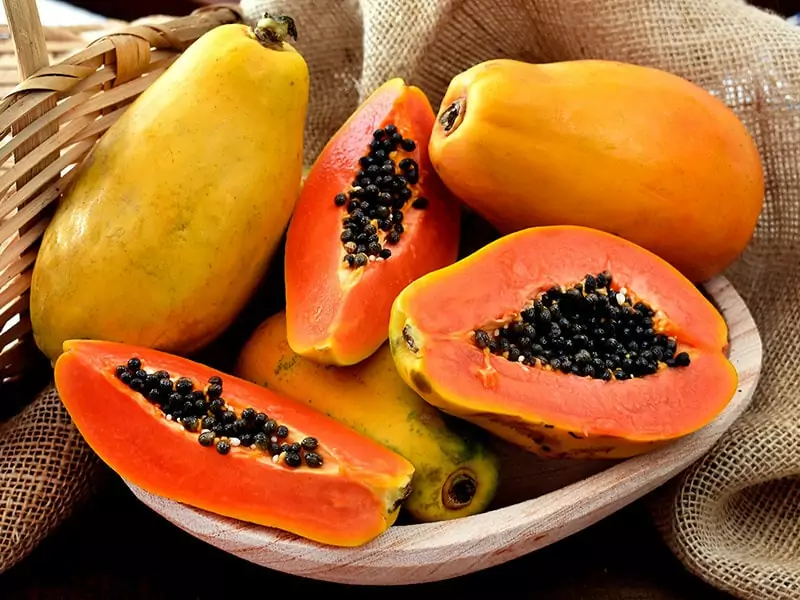
Papayas are grown extensively throughout the year in tropical regions. Like various other fruit types, papayas are healthy fruits with vitamins, minerals, and papain enzymes that are good for digestion.
After mastering how to cut and consume papayas, you can utilize this fruit for many purposes. Raw papaya can be used to make dishes such as salad and curries.
If you don’t know how to tell a papaya’s ripeness, you should learn how to do so now. Sweet and ripe papaya is an excellent addition to desserts, shakes, or smoothies. Additionally, papaya masks can help your skin be healthy and enhance skin elasticity.
You can store unripe papaya in a paper bag at room temperature to fasten the ripening process. Once you notice traces of a ripe papaya, place it in the fridge to slow down the process and avoid being overripe.
Since papaya takes up great space in the kitchen, knowing how to properly cut and consume papaya is important. Cut papaya can last for 2 days in the fridge. After that time, the fruit will slowly ripen and soften, remaining edible for another 5-7 days. For longer use, keep it in the freezer then you can make delicious smoothies.
Make a savory and beautiful dish of papaya salad.
16 Fascinating Varieties Of Papaya
Here are 16 papaya types with detailed insights. They vary in origin, color, weight, and other characteristics, but they all share 1 thing in common: papaya is an incredible fruit starting with P that can bring many benefits to your health.
First, let’s check the below table for some brief yet important information about these varieties.
1. Hawaiian Sunrise Papaya
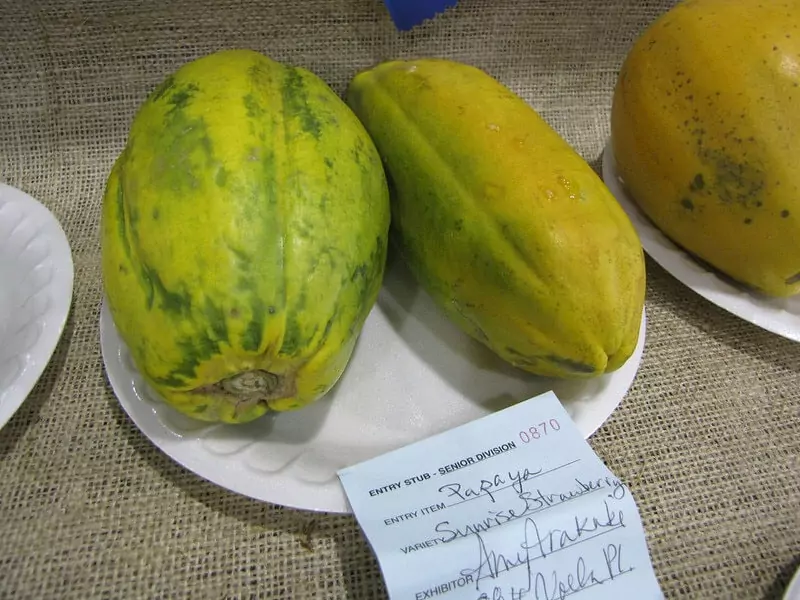
This variety has a unique and beautiful name.
You may know it by the name Strawberry papaya or Solo Sunrise Papaya. In 1961, the University of Hawaii propagated red-fleshed papaya (Kariya) and yellow-fleshed papaya (Line 9), which then resulted in two cultivars. And one of them is Sunrise Papaya.
This tasty Hawaiian fruit has a smooth peel, which becomes golden orange when ripening. Sunrise papaya has an oblong seed cavity shallower than other types of papayas. Its flesh has a salmon pink color, sweeter and low acid content. Its taste is a mix of melon and berries.
It contains carotene, vitamin A, vitamin C, vitamin E, vitamin K, and many minerals. It is also prized for papain, a type of enzyme that is good for your digestion.
Wanna take a close look at Hawaiian Sunrise papaya? Check it now!
2. Hawaiian Sunset Papaya
Hawaiian Sunset Papaya is Sunrise’s sister. It is smaller and firmer than Sunrise papaya. Another difference is that Sunset fruits can last 2-4 days longer than Sunrise, although people harvest these 2 types at the same maturity stage.
The skin has a nice red-orange color when ripening. The seed cavity has a star shape, so removing the seeds is easy. The flesh of Sunset has a salmon pink color. Another feature that makes Sunset papaya appealing is its distinctive aroma and flavor.
3. Kamiya Papaya
This is a variety of papaya developed by the University of Hawaii in the early 1960s. The original fruit had a deep star seed cavity, making it harder to remove the seeds.
Moreover, they used to be low-bearing trees. That’s why the University continued various extra trials to breed the best selection and named it Kamiya.
Kamiya papaya is a medium-sized fruit with a unique character: resistance to ringspot virus disease. Behind its thin greenish-yellow rind is orange flesh with a mild but delicate aroma. This papaya variety is sweet with high sugar content.
Let’s take a trip to Kamiya papaya farm and explore this amazing fruit.
4. Guinea Gold Papaya
Guinea Gold papaya is popular in Western Australia as this is the fruit’s birthplace. In the 20th century, scientists tested various papaya cultivars to see if they were suitable for cultivation in the region.
However, only Guinea Gold and Sunnybank produced enough yield with quality fruits for commercial purposes.
Speaking of Guinea Gold, this pear-shaped fruit is prized for its thin golden yellow peel and flesh, hence the name. Sweet and juicy, Guinea Gold papaya can weigh approximately 2.4 pounds.
5. Sunnybank Papaya
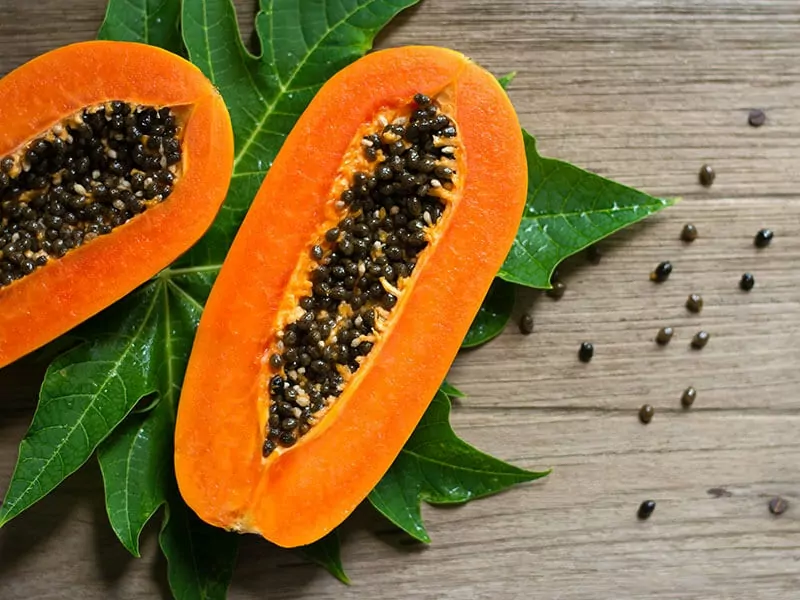
As mentioned before, Sunnybank was chosen to be commercially cultivated in Western Australia after many trials. It is one of the major crops in the region and has a long history with the land. If you are wondering about the origin of the name, the flesh is as golden as sunlight.
Sunnybank papaya is small in size. It weighs on average 1 pound. When you uncover the fruit, you can taste the sweetness behind its yellow flesh. The flowers are also quite fragrant and attractive to various pollinators, especially insects.
6. Kapoho Papaya
Kapoho papaya is popular in the Puna district of Hawaii. It accounts for 90% of the state’s total papaya production. This variety is very famous in American supermarkets due to its sweet and yellow flesh.
Kapoho papaya has a pear-like shape with firm pulp that can weigh up to 22 ounces. It is super sweet with high sugar content. This variety is rich in vitamin C, A, and E. If you can get your hand on some, enjoy them before they are overripe.
7. Mexican Papaya
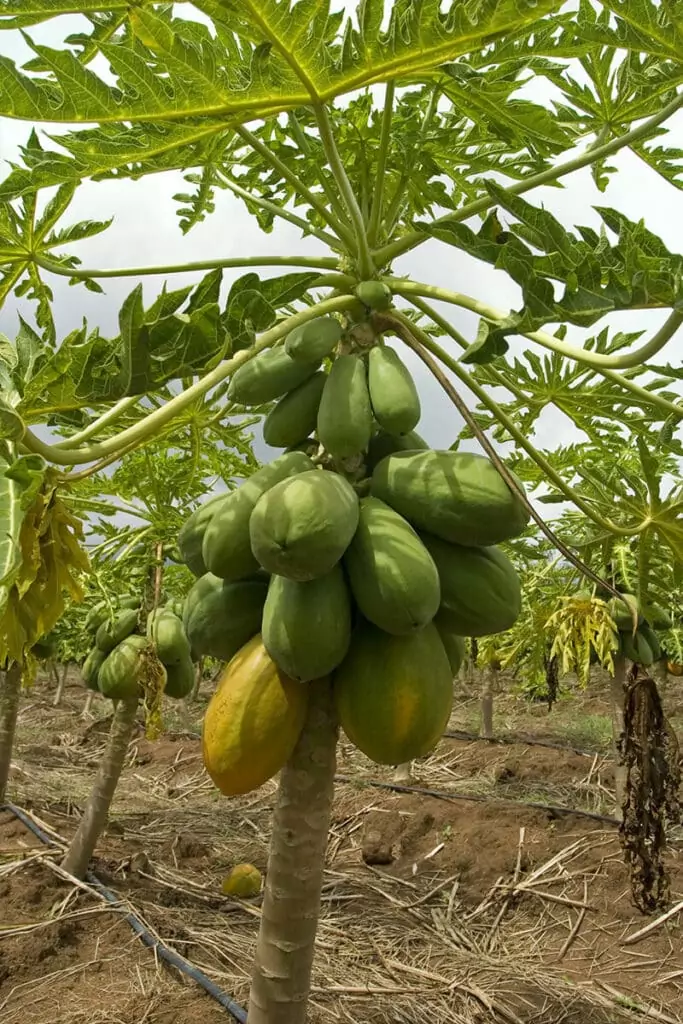
Papaya has been grown as a wild plant since ancient times. Today, you can see it cultivated in tropical countries worldwide for domestic use along with export. In regions such as Central America, Australia, and Asia, Mexican papaya mainly grows wild or as a home garden plant.
Mexican papaya has a wide range of varieties. Their length is usually around 6-12 inches and varies in shape from oval to pyriform. When it ripens, the skin turns bright yellow, orange, or pale green. Its flesh is sweet, mild, and yellow with a soft, dense texture.
Mexican papaya is a large fruit that can weigh up to 10 pounds. It provides vitamin C that boosts your immune system and reduces inflammation. It is high in minerals and vitamins, protects bones, and maintains your health.
Click here and have a look at how to harvest Mexican papayas and their storage for export.
8. Hortus Gold Papaya
The world’s oldest inhabited continent boasts some good papayas you have to try. Let’s meet Hortus Gold Papaya, which is native to South Africa. It is prized for having high sugar content and disease resistance. Another name for the cultivar is “Honey Gold”.
This round-oval papaya has beautiful golden-yellow skin with sweet flesh. It often becomes mushy when overripe. A Hortus Gold Papaya weighs on average 2-3 pounds.
9. Red Lady Papaya
Red Lady papaya is a Mexican variety well-known for its high-yielding characteristic along with disease resistance. A Red Lady papaya can weigh about 3-5 pounds. It can be grown in containers whose fruit often weighs about 2 pounds.
These large and oblong fruits from Mexico will turn bright yellow skin. Its flesh has a vibrant salmon pink hue with melon-like flavor and sweet aroma. The inner cavity contains small and round black seeds.
10. Waimanalo Papaya
Waimanalo papaya is a dwarf variety grown commercially almost entirely in Oahu, Hawaii. It is known as the smallest type as a dwarf variety. Its small size is usually enough for a person to eat.
Waimanalo papaya has a short neck and round ends. It weighs between 16 and 39 ounces. You can feel the creamy and sweet taste of its thick, orange-yellow flesh. On the other hand, Waimanalo is an excellent source of vitamin C.
11. Tainung Papaya
Tainung papaya is a variety originally developed in Taiwan. It is bred from the Sunrise papaya and is grown in most tropical countries all over the world.
This elongated fruit has a green rind and turns yellow when it matures. Its pink-red flesh has a sweet and juicy flavor with a hint of melon. Tainung papaya contains a large number of black seeds in the center. The seeds taste somewhat of pepper.
Tainung papaya is also prized for containing pigments such as lycopene and carotenoids which creates its distinctive color. Besides vitamins, minerals, and digestive enzymes, this fruit provides fiber and carbohydrates.
Tainung papaya is best ripened at room temperature when kept in a paper bag. Store them in the fridge and use them within 1-2 days.
12. Bettina Papaya
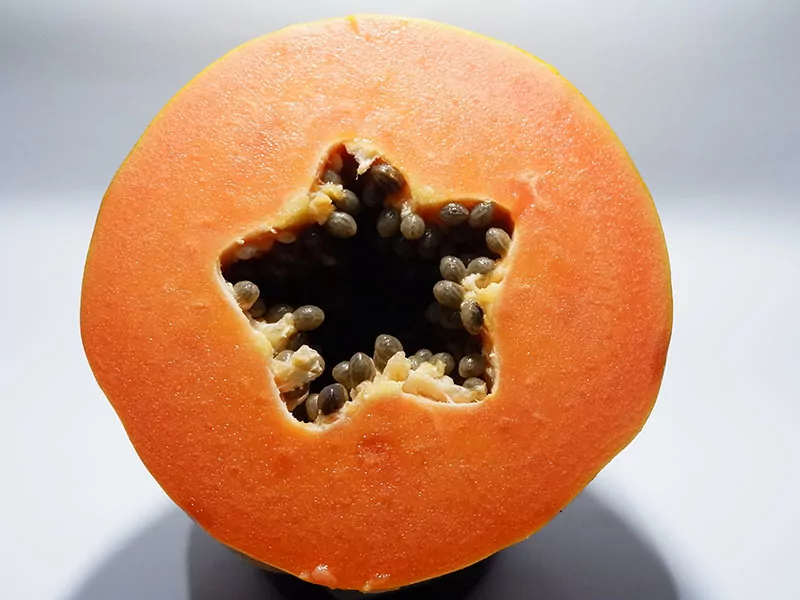
Bettina papaya is a variety of Carica papaya, which is propagated between Florida’s Betty and a Queensland strain. It has a long history of cultivation in Queensland, Australia.
This round-oval fruit has a yellow-orange skin color once ripening. When you peel them, you’ll have sweet flesh to enjoy. Bettina papaya is known for a small number of seeds in the cavity. A Bettina papaya can weigh 3-5 pounds.
13. Oak Leaved Papaya
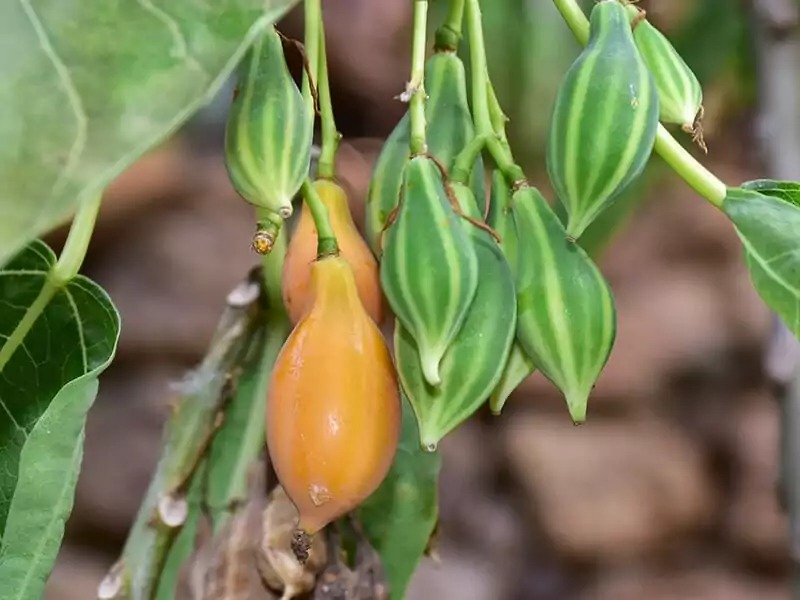
Oak Leaved papaya, also known as Oak Leaf papaya is a popular fruit in Western South America. It is not usually grown for commerce due to its small size and numerous seeds. Therefore, you may not know about this type of papaya.
This small fruit has edible seeds and an elongated oval shape with lines. Its flesh is orange and has a sweet, musky flavor. There are several blackish-green seeds inside.
Like all papaya varieties, Oak Leaved papaya contains papain that helps digestion function well. It is also rich in vitamin A and C and other minerals such as calcium, magnesium, and iron.
Let’s learn how to grow the oak-leaved papaya.
14. Samba Papaya
As a new variety, Samba Papaya was discovered around 2016 and first introduced in the US as a commercial product in 2018. Currently, it is not widely available but you can find it at specialty markets.
It has the same shape like a pear. The skin ripens from green to yellow and yellowish-orange. Its ripe flesh has a deep orange-red color. The cavity contains small and edible black seeds inside. Samba papaya has a slightly sweet taste.
This variety stands out from other types of papaya because of its nutritiousness. It is an excellent source of beta-carotene and amino acids. The large amount of omega-3, omega-6, and papain in the fruit can improve your digestion. It is also high in vitamins and minerals.
A whole Samba papaya can stay safe at room temperature for up to 2 weeks. You can store cut papaya in the fridge for 5 days.
15. Royal Star Papaya
This one is a natural hybrid variety of Mexican papaya that was discovered in 2007 in Colima, Mexico. Farms in the region as well as south Texas are the main producers of this fruit. Royal Star papaya first entered the US and Canadian markets in 2011.
As the name suggests, Royal Star papaya has a star-shaped cavity to contain its seeds. It is often harvested when green to ripen a few weeks later, when its skin turns yellow and becomes orange or red. Its firm, sweet, juicy flesh has a bright orange hue.
Due to a large amount of fructose, Royal Star papaya has become one of the sweetest varieties. It also contains vital vitamins and some minerals that are necessary for the body.
A whole Royal Star papaya can weigh 1-2 pounds. It stays good for up to 2 weeks, while cut papaya can be refrigerated for 5 days. You can freeze it to make frozen desserts.
Ultimate guide to growing a Royal Star papaya from its seed.
16. Maradol Papaya
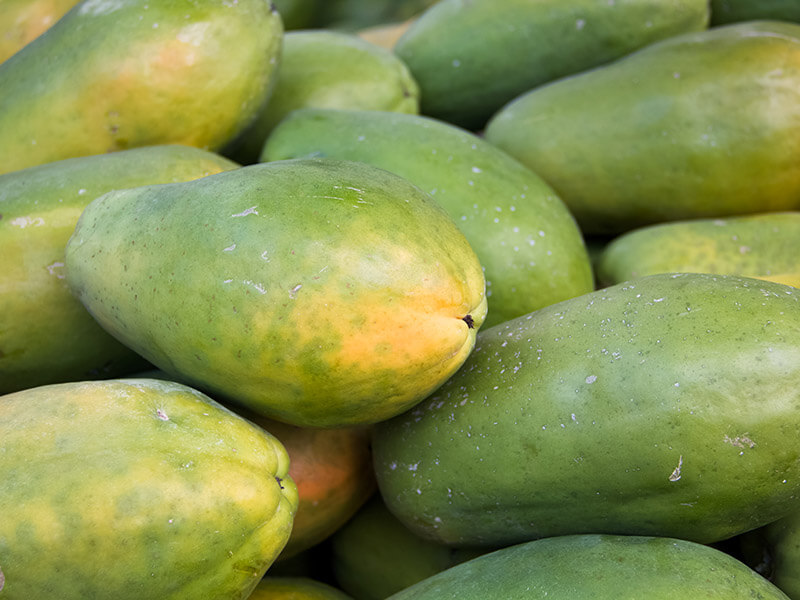
This variety of papaya is very famous in Mexico and Central America. This large, elongated fruit turns from green skin to yellow and then orange when fully ripening. When you peel it, you’ll uncover a bright salmon pink flesh with a firm but soft texture and a musky aroma.
Maradol papaya is known for its high amount of vitamin A, vitamin C, and papain enzymes. The edible seeds can provide compounds that protect your body from inflammation. Besides, they also have substances to boost your immunity and keep your internal organs healthy.
Maradol papaya can weigh 3-5 pounds. It also can ripen at room temperature and stay in good condition for 3 days. Cut papaya can be kept in the fridge for 2 days, but you can freeze it for a longer time.
You’ve Become An Expert In Papaya!
This list doesn’t cover every papaya variety, but the most popular ones are all in here. So how many types of papaya have you known before reading this list?
If you are lucky enough to taste any type of them, don’t forget to share your experience and let me know your opinion in the comment section.
I guess you’ve enjoyed a great time reading this post. Hopefully, it will broaden your knowledge about papaya. If you like this post and want more people to know about this fruit, share it with your family and friends. Thanks for reading!
